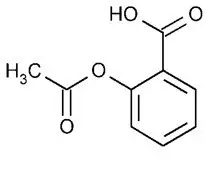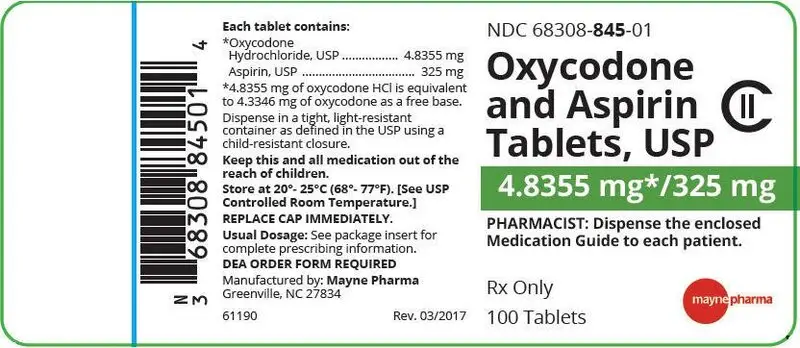Drug Detail:Percodan (Aspirin and oxycodone [ as-pir-in-and-ox-i-koe-done ])
Drug Class: Narcotic analgesic combinations
WARNING: ADDICTION, ABUSE, AND MISUSE; RISK EVALUATION AND MITIGATION STRATEGY (REMS); LIFE-THREATENING RESPIRATORY DEPRESSION; ACCIDENTAL INGESTION; NEONATAL OPIOID WITHDRAWAL SYNDROME; CYTOCHROME P450 3A4 INTERACTION; and RISKS FROM CONCOMITANT USE WITH BENZODIAZEPINES OR OTHER CNS DEPRESSANTS
Oxycodone Aspirin - Clinical Pharmacology
Contraindications
Oxycodone and aspirin tablets are contraindicated in patients with:
- Significant respiratory depression (see WARNINGS)
- Acute or severe bronchial asthma in an unmonitored setting or in the absence of resuscitative equipment (see WARNINGS)
- Known or suspected gastrointestinal obstruction, including paralytic ileus (see WARNINGS)
- Hypersensitivity to oxycodone or aspirin, (e.g. angioedema) (see WARNINGS)
- Patients with hemophilia.
- Aspirin should not be used in children or teenagers for viral infections, with or without fever, because of the risk of Reye syndrome (see WARNINGS)
Warnings
Addiction, Abuse, and Misuse
Oxycodone and aspirin tablets contain Oxycodone, a Schedule II controlled substance. As an opioid, oxycodone and aspirin tablets exposes users to the risks of addiction, abuse, and misuse (see DRUG ABUSE AND DEPENDENCE).
Although the risk of addiction in any individual is unknown, it can occur in patients appropriately prescribed oxycodone and aspirin tablets. Addiction can occur at recommended dosages and if the drug is misused or abused.
Assess each patient's risk for opioid addiction, abuse, or misuse prior to prescribing oxycodone and aspirin tablets, and monitor all patients receiving oxycodone and aspirin tablets for the development of these behaviors and conditions. Risks are increased in patients with a personal or family history of substance abuse (including drug or alcohol abuse or addiction) or mental illness (e.g., major depression). The potential for these risks should not, however, prevent the proper management of pain in any given patient. Patients at increased risk may be prescribed opioids such as oxycodone and aspirin tablets, but use in such patients necessitates intensive counseling about the risks and proper use of oxycodone and aspirin tablets along with intensive monitoring for signs of addiction, abuse, and misuse. Consider prescribing naloxone for emergency treatment of opioid overdose (see WARNINGS, Life-Threatening Respiratory Depression; DOSAGE AND ADMINISTRATION, Patient Access to Naloxone for the Emergency Treatment of Opioid Overdose).
Opioids are sought by drug abusers and people with addiction disorders and are subject to criminal diversion. Consider these risks when prescribing or dispensing oxycodone and aspirin tablets. Strategies to reduce these risks include prescribing the drug in the smallest appropriate quantity and advising the patient on the proper disposal of unused drug (see PRECAUTIONS; Information for Patients/Caregivers). Contact local state professional licensing board or state controlled substances authority for information on how to prevent and detect abuse or diversion of this product.
Life-Threatening Respiratory Depression
Serious, life-threatening, or fatal respiratory depression has been reported with the use of opioids, even when used as recommended. Respiratory depression, if not immediately recognized and treated, may lead to respiratory arrest and death. Management of respiratory depression may include close observation, supportive measures, and use of opioid antagonists, depending on the patient's clinical status (see OVERDOSAGE). Carbon dioxide (CO2) retention from opioid-induced respiratory depression can exacerbate the sedating effects of opioids.
While serious, life-threatening, or fatal respiratory depression can occur at any time during the use of oxycodone and aspirin tablets, the risk is greatest during the initiation of therapy or following a dosage increase. Monitor patients closely for respiratory depression, especially within the first 24-72 hours of initiating therapy with and following dosage increases of oxycodone and aspirin tablets.
To reduce the risk of respiratory depression, proper dosing and titration of oxycodone and aspirin tablets are essential (see DOSAGE AND ADMINISTRATION). Overestimating the oxycodone and aspirin tablets dosage when converting patients from another opioid product can result in a fatal overdose with the first dose.
Accidental ingestion of even one dose of oxycodone and aspirin tablets, especially by children can result in respiratory depression and death due to an overdose of oxycodone.
Educate patients and caregivers on how to recognize respiratory depression and emphasize the importance of calling 911 or getting emergency medical help right away in the event of a known or suspected overdose (see PRECAUTIONS, Information for Patients/Caregivers).
Opioids can cause sleep-related breathing disorders including central sleep apnea (CSA) and sleep-related hypoxemia. Opioid use increases the risk of CSA in a dose-dependent fashion. In patients who present with CSA, consider decreasing the opioid dosage using best practices for opioid taper (see DOSAGE AND ADMINISTRATION).
Risks of Concomitant Use or Discontinuation of Cytochrome P450 3A4 Inhibitors and Inducers
Concomitant use of oxycodone and aspirin tablets with a CYP3A4 inhibitor, such as macrolide antibiotics (e.g., erythromycin), azole-antifungal agents (e.g., ketoconazole), and protease inhibitors (e.g., ritonavir), may increase plasma concentrations of oxycodone and prolong opioid adverse reactions, which may cause potentially fatal respiratory depression (see WARNINGS), particularly when an inhibitor is added after a stable dose of oxycodone and aspirin tablets is achieved. Similarly, discontinuation of a CYP3A4 inducer, such as rifampin, carbamazepine, and phenytoin, in oxycodone and aspirin tablets-treated patients may increase oxycodone and aspirin tablets plasma concentrations and prolong opioid adverse reactions. When using oxycodone and aspirin tablets with CYP3A4 inhibitors or discontinuing CYP3A4 inducers in oxycodone and aspirin tablets-treated patients, monitor patients closely at frequent intervals and consider dosage reduction of oxycodone and aspirin tablets until stable drug effects are achieved (see PRECAUTIONS; Drug Interactions).
Concomitant use of oxycodone and aspirin tablets with CYP3A4 inducers or discontinuation of an CYP3A4 inhibitor could decrease oxycodone plasma concentrations, decrease opioid efficacy or, possibly, lead to a withdrawal syndrome in a patient who had developed physical dependence to oxycodone. When using oxycodone and aspirin tablets with CYP3A4 inducers or discontinuing CYP3A4 inhibitors, monitor patients closely at frequent intervals and consider increasing the opioid dosage if needed to maintain adequate analgesia or if symptoms of opioid withdrawal occur (see PRECAUTIONS; Drug Interactions).
Withdrawal
Do not abruptly discontinue oxycodone and aspirin tablets in a patient physically dependent on opioids. When discontinuing oxycodone and aspirin tablets, in a physically dependent patient, gradually taper the dosage. Rapid tapering of oxycodone and aspirin tablets in a patient physically dependent on opioids may lead to a withdrawal syndrome and return of pain (see DOSAGE AND ADMINISTRATION, DRUG ABUSE AND DEPENDENCE).
Additionally, avoid the use of mixed agonist/antagonist (i.e., pentazocine, nalbuphine, and butorphanol) or partial agonist (e.g., buprenorphine) analgesics in patients who have received or are receiving a course of therapy with a full opioid agonist analgesic, including oxycodone and aspirin tablets. In these patients, mixed agonist/antagonist and partial agonist analgesics may reduce the analgesic effect and/or precipitate withdrawal symptoms (see PRECAUTIONS, Drug Interactions).
Precautions
Information for Patients/Caregivers
Advise the patient to read the FDA-approved patient labeling (Medication Guide).
Pregnancy
Risk Summary
Use of NSAIDs, including aspirin, can cause premature closure of the fetal ductus arteriosus and fetal renal dysfunction leading to oligohydramnios and, in some cases, neonatal renal impairment. Because of these risks, limit dose and duration of oxycodone and aspirin tablet use between about 20 and 30 weeks gestation, and avoid oxycodone and aspirin tablet use at about 30 weeks of gestation and later in pregnancy (see WARNINGS; Fetal Toxicity].
Lactation
Adverse Reactions/Side Effects
The following serious adverse reactions are described, or described in greater detail, in other sections:
- Addiction, Abuse, and Misuse (see WARNINGS)
- Life-Threatening Respiratory Depression (see WARNINGS)
- Neonatal Opioid Withdrawal Syndrome (see WARNINGS)
- Interactions with Benzodiazepines and Other CNS Depressants (see WARNINGS)
- Adrenal Insufficiency (see WARNINGS)
- Severe Hypotension (see WARNINGS)
- Gastrointestinal Adverse Reactions (see WARNINGS)
- Seizures (see WARNINGS)
- Withdrawal (see WARNINGS)
Oxycodone Aspirin Dosage and Administration
Patient Access to Naloxone for the Emergency Treatment of Opioid Overdose
Discuss the availability of naloxone for the emergency treatment of opioid overdose with the patient and caregiver and assess the potential need for access to naloxone, both when initiating and renewing treatment with oxycodone and aspirin tablets (see WARNINGS, Life-Threatening Respiratory Depression; PRECAUTIONS, Information for Patient/Caregivers).
Inform patients and caregivers about the various ways to obtain naloxone as permitted by individual state naloxone dispensing and prescribing regulations (e.g., by prescription, directly from a pharmacist, or as part of a community-based program).
Consider prescribing naloxone, based on the patient's risk factors for overdose, such as concomitant use of CNS depressants, a history of opioid use disorder, or prior opioid overdose. The presence of risk factors for overdose should not prevent the proper management of pain in any given patient (see WARNINGS, Addition, Abuse, and Misuse, Life-Threatening Respiratory Depression, Risks from Concomitant Use with Benzodiazepines or Other CNS Depressants).
Consider prescribing naloxone when the patient has household members (including children) or other close contacts at risk for accidental ingestion or overdose.
Drug Abuse and Dependence
| OXYCODONE AND ASPIRIN
oxycodone hydrochloride and aspirin tablet |
||||||||||||||||||
|
||||||||||||||||||
|
||||||||||||||||||
|
||||||||||||||||||
|
||||||||||||||||||
|
||||||||||||||||||
|
||||||||||||||||||
| Labeler - Mayne Pharma Inc. (867220261) |
| Establishment | |||
| Name | Address | ID/FEI | Business Operations |
|---|---|---|---|
| Mayne Pharma Inc. | 867220261 | MANUFACTURE(68308-845) , ANALYSIS(68308-845) , PACK(68308-845) , LABEL(68308-845) | |







